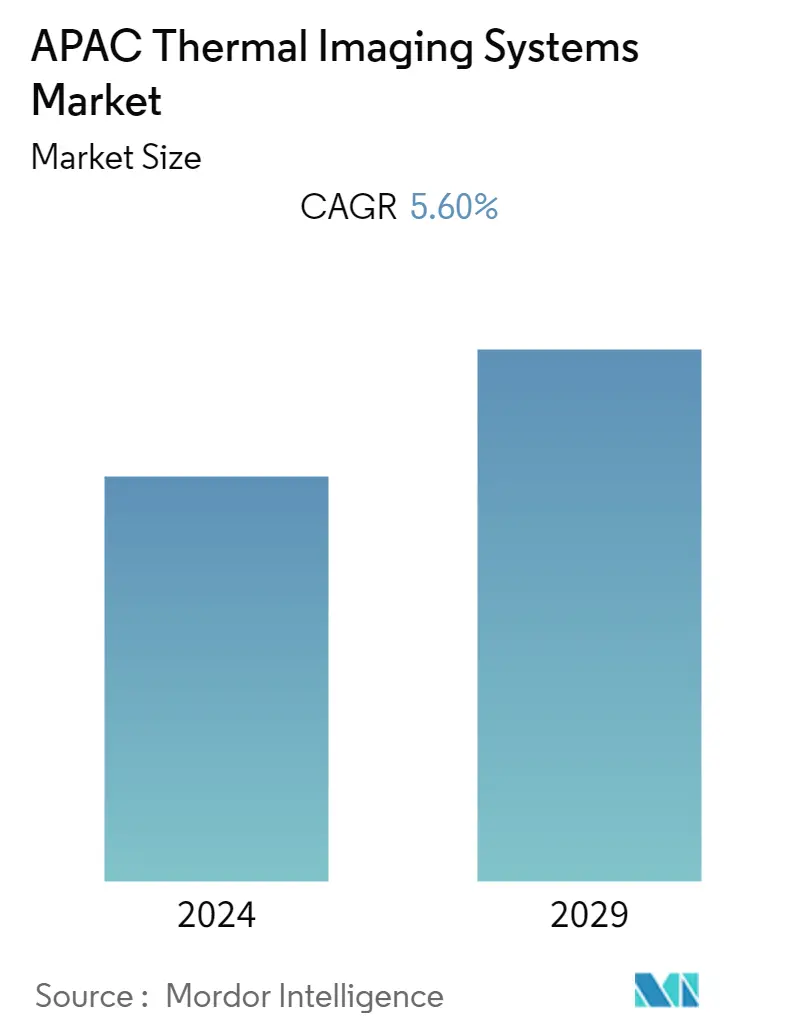Market Size of APAC Thermal Imaging Systems Industry

| Study Period | 2019 - 2029 |
| Base Year For Estimation | 2023 |
| Forecast Data Period | 2024 - 2029 |
| Historical Data Period | 2019 - 2022 |
| CAGR | 5.60 % |
| Market Concentration | High |
Major Players
*Disclaimer: Major Players sorted in no particular order |
Need a report that reflects how COVID-19 has impacted this market and its growth?
APAC Thermal Imaging Systems Market Analysis
Asia Pacific Thermal Imaging Systems market is expected to reach a CAGR of 5.6% over the forecast period (2021 - 2026). The outbreak of the COVID-19 virus has disrupted the supply chain globally, especially in hardware, electronic manufacturing, and semiconductor companies. However, market demand is likely to increase, and several players are launching new products. For instance, in May 2020, Honeywell International, Inc. introduced an AI-enabled thermal imager that detects elevated body temperatures at the entryway of factories, airports, distribution centers, and other commercial buildings.
- Thermal imaging detects a long IR range of the electromagnetic spectrum, which is invisible to the human eye by means of special and sophisticated cameras called Infrared Imagers. Thermal imaging systems have witnessed a paradigm shift in recent years due to their increasing use in military and defense applications. The army and navy popularly use it for border surveillance and law enforcement. It is also used in ship collision avoidance and guidance systems, whereas in the aviation industry, it has greatly mitigated the risks of flying in low light and night conditions.
- To cope with diversely asymmetric, multi-dimensional, and highly lethal imperatives of the battlefield, global armies are modernizing their military arsenal and getting soldiers geared up with the latest in combat and surveillance technology. Motion detection is one of the important element of Automatic Target Recognition (ATR) and perimeter monitoring systems. Thermal imaging has become an integral part of these systems because of its ability to operate in all weather conditions.
- Further, the advent of smartphones as cost-effective handheld/portable thermal imaging devices is expected to increase technology adoption. Caterpillar(Cat) companies have integrated FLIR's thermal imaging camera in the Cat S60 and the latest Cat S61 smartphones.
- Moreover, electrical installations in buildings like an office complex, residential complex, or shopping complex like a mall are mostly located at places with poor air ventilation. Again, it requires an effective maintenance schedule to avoid any mishap. Various surveys in different sectors have shown that predictive maintenance using thermal imaging has saved up to 40% of the maintenance cost and 50% of the plant process's downtime. These factors have a positive outlook on the handheld thermal imaging equipment market.
- Furthermore, It has been expected that the adoption of significant volumes of thermal cameras for SAE automation levels 2 and 3 will likely start in 2022 or 2023, with high annual growth rates. According to UBS, Nvidia, and Intel, the expected autonomous vehicle registration share would reach 12% in 2030 from 0.1% in 2021, and thermal imaging might be the technology autonomous vehicles need to reach level five. Such trends are accelerating the need for thermal imaging systems in the Asia Pacific.
